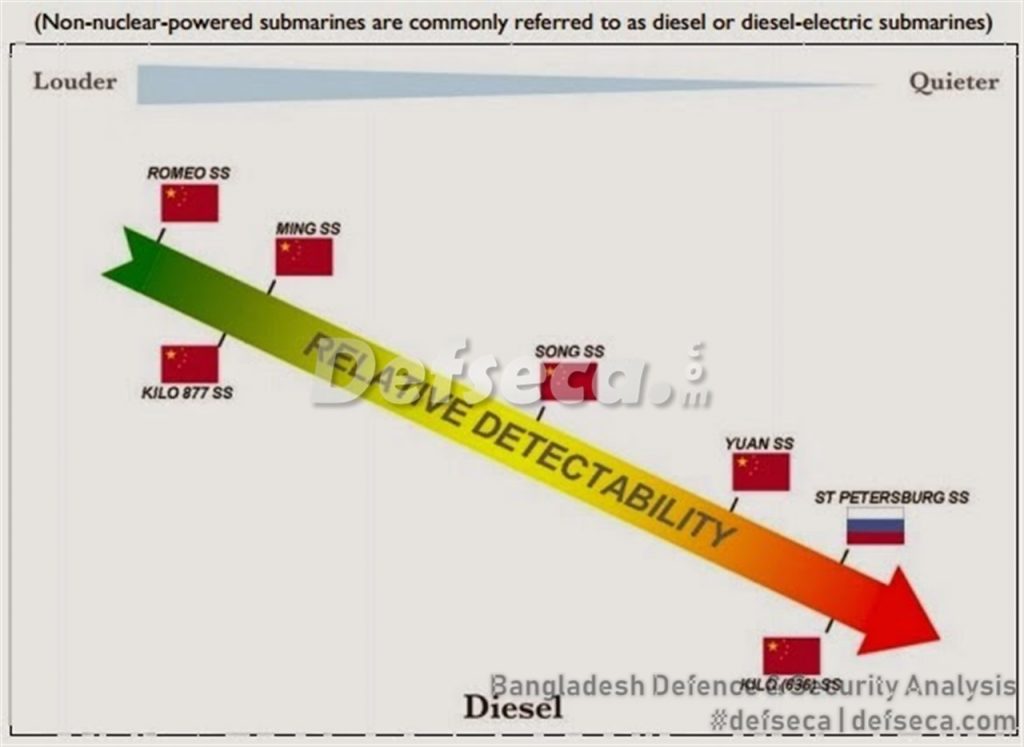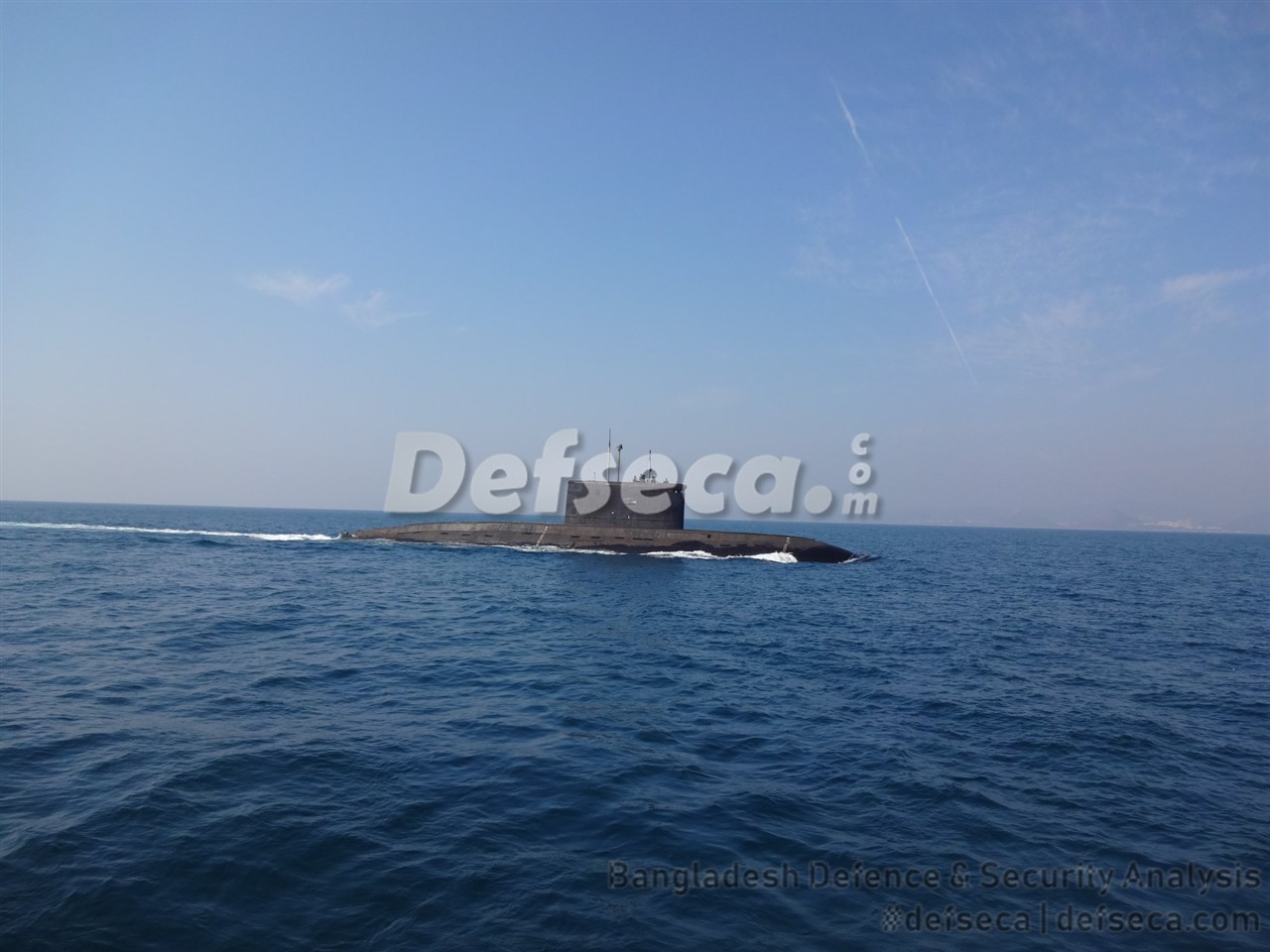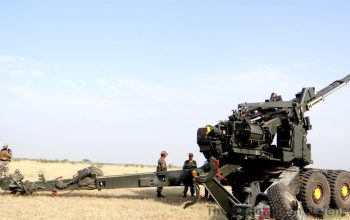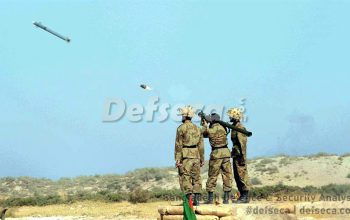Sindhughosh-class submarines are Kilo-class diesel-electric submarines in active service with the Indian Navy. The Sindhughosh submarines, designated 877EKM, were designed as part of Project 877, and built under a contract between Rosvooruzhenie and the Ministry of Defence (India).
The submarines have a displacement of 3,000 tonnes, a maximum diving depth of 300 metres, top speed of 18 knots, and are able to operate solo for 45 days with a crew of 53. The final unit (S65 Sindhurashtra) was the first to be equipped with the 3M-54 Klub (SS-N-27) anti-ship cruise missiles with a range of 220 km.
Life extension and refit programs
INS Sindhuvijay has been upgraded with the hydro acoustical USHUS complex and the CCS-MK radio communications system. On 29 August 2014 DAC cleared the long-awaited mid-life upgrade of the four Kilo-class submarines, which would be carried out in Indian shipyards and costs Rs 4,800 million. On 5 November 2014 official sources at HSL said more than 90% of the work has been completed on the seventh submarine of the Sindhughosh class INS Sindhukirti. Scheduled to re-join the fleet on 31 March 2015, she re-entered service on 23 May.
The Indian Navy signed a contract with the Russian shipbuilder Sevmash to refit and upgrade the existing submarines and to extend their operational life by 35 years. The first submarine, INS Sindhukesari, will be sent for refit starting June 2016. The extensive refit, the value for which is pegged at Rs 5,000 crore for a total of four submarines, will not only extend the life of the boats but will also upgrade their combat potential and fitted with Klub land attack cruise missile.
In 2015, the naval exercise Malabar, between the navies of India and the United States, involved Sindhudhvaj and USS City of Corpus Christi hunting each other. India Today reported that Sindhudhvaj managed to track Corpus Christi and score a simulated kill without being detected.
In December 2015, L&T was chosen by the Russian shipbuilder Sevmash to be its Indian partner in the refit project. While the first of the four Kilo class subs will go to the Russian Zvezdochka shipyard for inspection and refit, the remaining three are likely to be modernised at the Kattupalli shipyard. The first of the submarines to be modernized at private yard, a first for India, will go in by 2017, An order for 2-3 more submarines could also be commissioned, depending on ongoing acquisition plans of the Indian Navy.
Incidents
The Sindhughosh class has been plagued by incidents since late 2000’s.
On 10 January 2008, INS Sindhughosh collided with the cargo ship MV Leeds Castle. The submarine was reported to have sustained superficial damage to its conning tower. As a result, the submarine was out of service for a month. The cargo ship was in restricted shallow waters.
On 26 February 2010, a fire on board INS Sindhurakshak killed one sailor and injured two others. The fire was due to a defective battery.
On 14 August 2013 an explosion, followed by a fire, was reported to have occurred on Sindhurakshak. Sindhurakshak sank in the dock.
On 17 January 2014, Sindhughosh ran aground due to the low tide, while returning to the Naval Dockyard, Mumbai.
On 26 February 2014, smoke was detected on board INS Sindhuratna resulting in 7 sailors being rendered unconscious and two dead. Those unconscious were airlifted to hospital.
There have been no reports of incidents involving the submarines from any of the other operators.
China operates two Original Kilo subs and 10 Improved Kilos which is a more advanced version of the submarine. The Improved Kilo submarine is armed with six 533-mm torpedo tubes (the vessel carries 18 torpedoes or 24 mines) it is also capable to launch the SS-N-27 Club-S land attack cruise missiles. For self defence the submarine is equipped with Strela-3M or Igla-1 man-portable Air Defense missiles (MANPADS).
India had recently upgraded the INS Sindhurakshak and the INS Sindhuratna was being sea tested after a refit. The overhauled Indian submarines are equipped with 3M-54 Club-S (SS-N-27) anti-ship cruise missiles, the Indian-developed USHUS sonar, CCS-MK radio communications system and Porpoise radar.
Transfer to Myanmar Navy
The Sindhuvir (S58) was sold to the Myanmar Navy in 2019 for about $100 million. The submarine will be refitted before delivery to the Myanmar Navy by the end of 2019. It is unclear if the Sindhuvir (S58) is capable of firing the Club-S anti-ship missile. In any case Myanmar would have to obtain the munitions from Russia separately because the sales fee includes only the training and minor refit of the submarine.
Ships of the class
| Pennant | Name | Builder | Commissioned | Decommissioned | Status |
| S55 | Sindhughosh | Sevmash | 30 April 1986 | Refitted to Project 08773 2002-2005 at Zvezdochka shipyard. | |
| S56 | Sindhudhvaj | Sevmash | 12 June 1987 | To be Refitted to Project 08773. | |
| S57 | Sindhuraj | Sevmash | 20 October 1987 | To be Refitted to Project 08773. | |
| S58 | Sindhuvir | Sevmash | 26 August 1988 | 2019 | Refitted to PProject 08773 1997-1999 at Zvezdochka shipyard. Sold to Myanmar Navy in 2019. |
| S59 | Sindhuratna | Sevmash | 22 December 1988 | Refitted to Project 08773 2001-2003 at Zvezdochka shipyard. | |
| S60 | Sindhukesari | Sevmash | 16 February 1989 | To be Refitted to Project 08773. | |
| S61 | Sindhukirti | Sevmash | 4 January 1990 | Refitted to Project 08773 from 2007-2015 in her home base Vishakhapatnam. | |
| S62 | Sindhuvijay | Sevmash | 18 March 1991 | Refitted to Project 08773 2005-2007 at Zvezdochka shipyard. | |
| S63 | Sindhurakshak | Sevmash | 24 December 1997 | 5 September 2017 | Refitted to Project 08773 09.08.2010-2012 at Zvezdochka shipyard. Exploded and sank in Mumbai 14 August 2013. |
| S65 | Sindhurashtra | Sevmash | 19 July 2000 | To be Refitted to Project 08773. |
Class overview
- Name: Sindhughosh class
- Operators: Indian Navy
- Preceded by: Vela class
- Succeeded by: Kalvari class
- In commission: 1986–
- Planned: 10
- Completed: 10
- Active: 9
- Retired: 1
General characteristics
- Type: Submarine
- Displacement:
- 2,325 t (2,288 long tons) surfaced
- 3,076 t (3,027 long tons) submerged
- Length: 72.6 m (238 ft 2 in)
- Beam: 9.9 m (32 ft 6 in)
- Draught: 6.6 m (21 ft 8 in)
- Propulsion:
- 2 × diesel-electric motors, 3,650 hp (2,722 kW) each
- 1 × motor, 5,900 hp (4,400 kW)
- 2 × auxiliary motors, 204 hp (152 kW)
- 1 × economic speed motor, 130 hp (97 kW)
- Speed:
- 10 knots (19 km/h; 12 mph) surfaced[verification needed]
- 17 knots (31 km/h; 20 mph) submerged[verification needed]
- Range:
- 6,000 mi (9,700 km) at 7 kn (13 km/h; 8.1 mph) snorkeling
- 400 mi (640 km) at 3 kn (5.6 km/h; 3.5 mph) submerged
- Maximum operational depth: 250 metres
- Complement: 53 (13 Officers)
- Armament:
- Club-S missile (Some units)
- Type 53-65 torpedo
- TEST 71/76 anti-submarine, active-passive homing torpedo 24 × DM-1 mines in lieu of torpedoes





